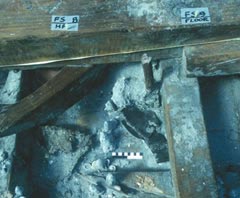Shipwreck Tantura Harbor, Israel |
Digging in Water
Underwater archaeologists operate under very different excavation circumstances that present problems quite distinct from those encountered by dirt archeologists. For example, it is difficult, if not impractical, to revisit an underwater site after excavation, whether by the investigators or by their colleagues or the general public; it is difficult to obtain good color images of wreck remains or its artifacts due to the water, particles in water, and absence of natural light; and it is difficult to appreciate the entire site from a distance, unlike typical land-based sites. Traditionally, then, publications of underwater wreck sites rely on detailed drawings of the ship’s timbers or interesting joints, lengthy descriptions of the remains, and a few representative photos of selected timbers or portions of the site.click on the image to enlarge

Detail photo of timbers from the Tantura B shipwreck © 1996 Institute of Nautical Archeaology - used with permission |
The Tantura team wanted something different and more informative. The Tantura excavation report was being prepared when VIZIN was contacted to create adjunct interactive materials for the publication. Since data were not collected by the excavators with digital production in mind, we needed to work especially closely with them to learn about the nature of their evidence and inform them about the processes of converting 2D images into interactive 3D computer models.
One of the goals set by the project team was to allow readers of the publication to simulate re-diving the Tantura Lagoon wrecks and, at the same time, to access excavation data by simply clicking on portions of the ship remains, as if the readers were underwater with immediate access to all of the documentation (potentially 100s of high-resolution color photographs and drawings, and descriptions, all the evidence that could not be provided to the audience by conventional static 2D publication methods).
Reference
Page Created: October 5, 2004
Page Updated: October 5, 2004
URL:
Page Author: The Institute for the Visualization of History